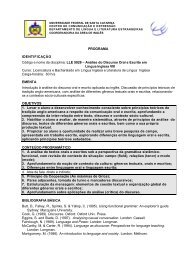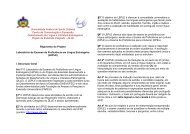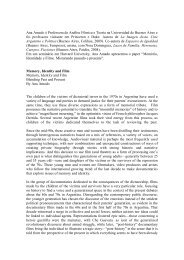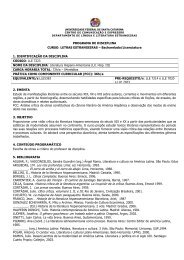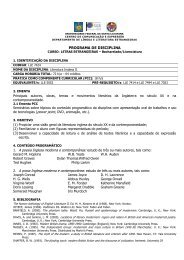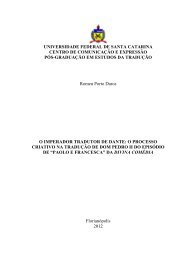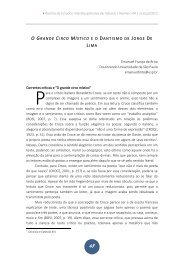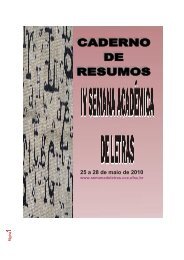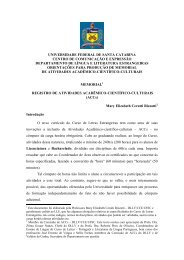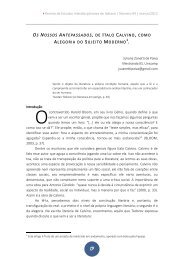Create successful ePaper yourself
Turn your PDF publications into a flip-book with our unique Google optimized e-Paper software.
BOLETÌN DE ESTÈTICA 10 – JUNIO 2009 – ISSN 1668-7132ANTELO - ROGER CAILLOIS: MAGIA, METÁFORA, MIMETISMOmovimiento <strong>de</strong> las piezas, vale <strong>de</strong>cir que, <strong>de</strong> lo que se trata, a su juicio,es <strong>de</strong> <strong>de</strong>terminar un punto <strong>de</strong> <strong>de</strong>sconstrucción, una bisagra posfuncionalque, al mismo tiempo y en toda ocasión, satisfaga variasexigencias discordantes, en un mismo sistema <strong>de</strong> relaciones. Le interesaa Caillois, entonces, la sintaxis <strong>de</strong> las combinaciones, que remitesiempre a lo singular 35 , aunque no exactamente a lo individual. Ese35Cf. Caillois, Cases d’un échiquier, París, Gallimard, 1970. En cuanto al concepto <strong>de</strong>singular, común a Foucault, Deleuze y otros teóricos contemporáneos, amén <strong>de</strong>l Sersingular-plural <strong>de</strong> Nancy, recor<strong>de</strong>mos que Peter Hallward cree que “Deleuze (…)pursues a fully singular conception of the individual, Foucault a fully specific one.This distinction says more about their fundamental projects than the many and generallyfamiliar thematic resemblances that linked their work and justified their mutualadmiration. For these two approaches to individuation, singular and specific, arepoles apart. The singular is aspecific. If a specific individual is one which exists as partof a relationship to a context, to other individuals and to itself, a singular individualis one which like a Creatorgod transcends all such relations. A singularity creates themedium of its own existence or ‘expression’, in Spinoza’s sense. Examples of singularlogics inclu<strong>de</strong> the sovereign of absolutist political theory, the proletariat of Marxist–Leninism, and the market affirmed by contemporary global capital; each constitutesitself through itself, to the exclusion of others (other sovereigns, other classes, othermarkets …). The singular recognises no limits. The specific, on the other hand, existsonly in the medium of relations with others, and turns ultimately on the confrontationof limits –the limits, for instance, of experience, of language, of knowledge, ofexpression, of introspection …The essential difference between Deleuze and Foucault,then, can be stated very simply: Deleuze seeks to write a philosophy withoutlimits (through immediate intuition of the unlimited, or purely creative), whereasFoucault writes a philosophy of the limit as such (at the limits of classification, at theedge of the void that lies beyond every or<strong>de</strong>r of recognition or normalisation)”. Cf.Hallward, Peter, “The limits of individuation or how to distinguish Deleuze and Foucault”,Angelaki. Journal of the Theoretical Humanities, volume 5, nº 2, agosto <strong>de</strong>2000. Caillois está pues más cerca <strong>de</strong> Foucault que <strong>de</strong> Deleuze. En la medida en que,gracias al mimetismo, la imagen abierta es tan sólo un paradigma, un esquema enrigor vacío, un Ur-fenômeno, entonces, cada evento, cada singularidad es sólo unejemplo pleno, una presencia situada <strong>de</strong> una recurrencia cíclica. Fredric Jameson, enMo<strong>de</strong>rnidad singular, admite ser imposible no periodizar la mo<strong>de</strong>rnidad y por elloafirma que la mo<strong>de</strong>rnidad no es un concepto sino una categoría narrativa. La mo<strong>de</strong>rnidadson relatos. Consecuentemente, no hay relato que pueda organizarse enpunto, a su juicio, es el <strong>de</strong> la <strong>de</strong>si<strong>de</strong>ntificación, como suspensión <strong>de</strong>las oposiciones binarias, y se conecta con la búsqueda, en Duchamp,<strong>de</strong> un más allá <strong>de</strong> la pintura y un más allá <strong>de</strong>l género, lo que nos conduce,a su vez, a la rearticulación anagramática <strong>de</strong>l lenguaje. A ese saber,<strong>de</strong>nominado ciencia diagonal, Caillois <strong>de</strong>dicaría, en 1960, un libro,Medusa & Cia 36 , cuyo provecho los Seminarios <strong>de</strong> Lacanatestiguan en más <strong>de</strong> una ocasión. De manera igualmente recurrente,Caillois aproxima el jugador <strong>de</strong> ajedrez al <strong>de</strong>tective, con lo cual, podríamos<strong>de</strong>cir, afianza la i<strong>de</strong>ntidad entre el juego y la mo<strong>de</strong>rnidad o entreel juego y el po<strong>de</strong>r. En su texto sobre Men<strong>de</strong>leiev, por ejemplo,propone la tabla <strong>de</strong> elementos como un tablero real o virtual, lo quesólo confirma la unidad <strong>de</strong>l universo, el ordo rerum analizado porMauss, la signatura rerum propuesta por Agamben.A título ilustrativo, recor<strong>de</strong>mos que Caillois se <strong>de</strong>slumbra ante el cielo<strong>de</strong> la pampa y admite, como un caso <strong>de</strong> las virtu<strong>de</strong>s dionisíacas que élmismo analizara en Acéphale, que lo celeste no es sino exceso <strong>de</strong> lo terrestre,transmutación activa <strong>de</strong> lo pasivo, pliegue <strong>de</strong> soberanía e impotenciaambivalentemente conjugadas. Tales i<strong>de</strong>as son <strong>de</strong>sarrolladas enlas conferencias que Caillois dicta en la Universidad <strong>de</strong> Buenos Airesen el invierno <strong>de</strong> 1939. En la <strong>de</strong>l 20 <strong>de</strong> julio, por ejemplo, al abordar laconquista <strong>de</strong>l cielo a través <strong>de</strong>l constructor <strong>de</strong> Babel, el rey Nemrod, y<strong>de</strong>sestimando el tema <strong>de</strong> la confusión lingüística, argumentaba allí quetorno a categorías <strong>de</strong> conciencia o subjetividad, porque estas son <strong>de</strong> imposible representación.Cualquier relato podrá, cuando mucho, dar cuenta <strong>de</strong> situaciones <strong>de</strong> mo<strong>de</strong>rnidady, en ese sentido, la situación contemporánea por excelencia muestra serimposible narrar la mo<strong>de</strong>rnidad sin dar cuenta <strong>de</strong>l impacto posmo<strong>de</strong>rno sobre todaslas categorías <strong>de</strong> mo<strong>de</strong>rnidad, subjetividad, tiempo, historia, memoria... Cf. Jameson,Fredric, Una mo<strong>de</strong>rnidad singular. Ensayo sobre ontología <strong>de</strong>l presente, Barcelona,Gedisa, 2004. Ver también Attridge, Derek, The Singularity of Literature, London,Routledge, 2004.36Cf. Caillois, Medusa y Cía: pintura, camuflaje, disfraz y fascinación en la naturalezay el hombre, trad. <strong>de</strong> Manuel F. Delgado, Barcelona, Seix Barral, 1962.2425



